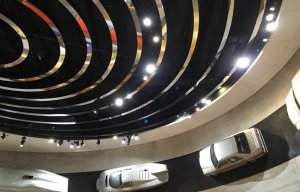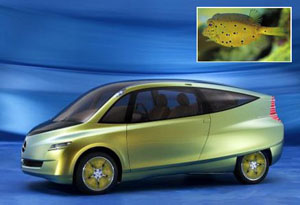
Hybrids dominate at Composites Europe 2018
The boxfish (Ostraciidae) was the rather unlikely role model for the design of the Mercedes Bionic concept car, attendees at the recent 49th Dornbirn Manmade Fibres Conference in Austria were told. Matthias Runar, of the Mercedes design centre at Sindelfingen in Germany, which houses 420 of the company’s 500+ designers, explained in Dornbirn that bionics is being integrated into design processes, primarily to find new ways of cons

4th October 2010
Innovation in Textiles
|
Dornbirn

The boxfish (Ostraciidae) was the rather unlikely role model for the design of the Mercedes Bionic concept car, attendees at the recent 49th Dornbirn Manmade Fibres Conference in Austria were told.
Matthias Runar, of the Mercedes design centre at Sindelfingen in Germany, which houses 420 of the company’s 500+ designers, explained in Dornbirn that bionics is being integrated into design processes, primarily to find new ways of conserving fuel.
The boxfish, they discovered, is an excellent example of an aerodynamic animal, so engineers patterned the car on its unique features, mimicking its streamlined profile adopting the animal’s boxy frame to increase strength and stability.
The skin of the boxfish consists of numerous hexagonal, bony plates that makes it very strong, yet the fish itself is very light. The structure of the bionic car uses the principles of its bone formation to allow for a very light weight with high rigidity.
The result is certainly a car that looks unlike anything Mercedes has come up with before.
The boxfish also inspired the car interior, which makes extensive use of spacer fabrics for lightweight insulation, along with a 3D film which creates the impression of there being more space than there actually is. 3D film flexible foams, polyamide components and an orange plexiglass stripe were also used in the attempt to mimic the skin structure of the boxfish. The interior outer fabric is Alcantara microfilament artificial leather.
Drawing on biology to develop new technology – the concept known as bionics – enabled the designers to create a diesel-powered car prototype that can achieve speeds of up to 118 miles an hour and boasts fuel economy of 70 miles per gallon.
“The use of bionic principles is an opportunity to create new ideas and approaches,” said Mr Runar. “It allows new form languages in car design and therefore the potential to differentiate from the competition. New concepts and materials support the claim of Mercedes-Benz to be a pioneer in design, technology and innovation.”

Business intelligence for the fibre, textiles and apparel industries: technologies, innovations, markets, investments, trade policy, sourcing, strategy...
Find out more